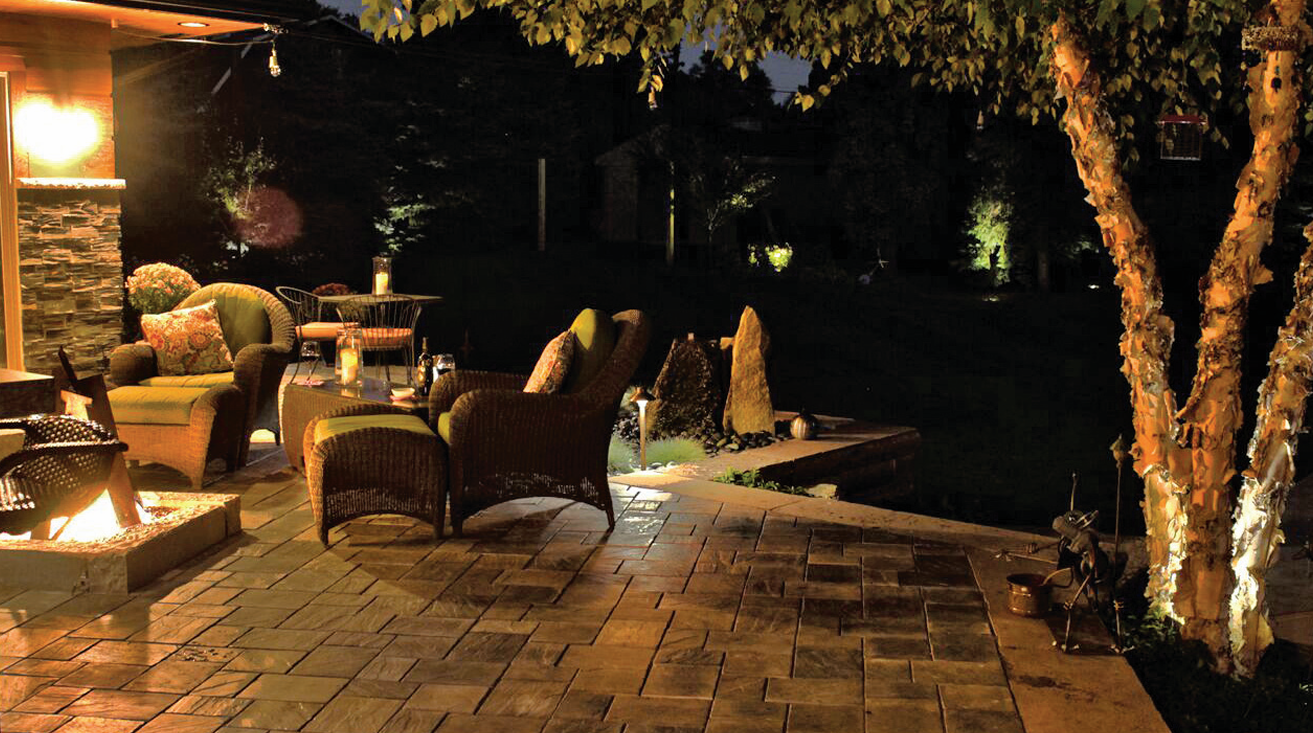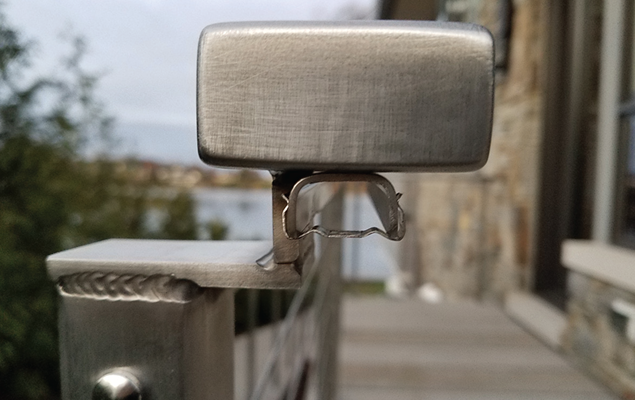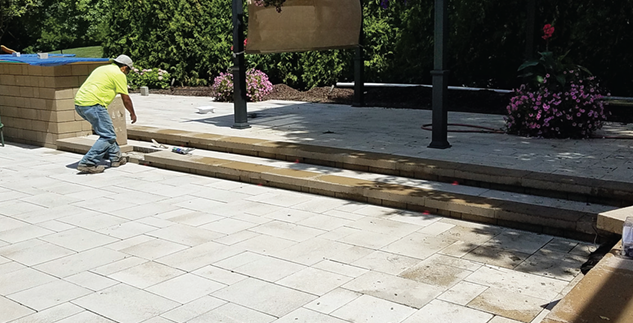Articles
/
Articles /
LUMENILAIRE - A Collage of Color - Mike Dahl, LC/DBM
ABOVE LEFT: Besides providing safety and security, and enhancing the beauty of this model house and landscape in Ann Arbor, Mich., the owners wanted the lighting system to be colorful and flexible. D.A. Alexander & Company installed one that was developed by Lumenilaire, who also handled the design management of this project. The system consists of two types of fixtures and a wireless controller, which is operated by a custom smartphone app that can control each fixture‘s color and intensity by activating the separate red, green, blue, and white LED chips in the RGBW LEDs (see sidebar) and adjusting the voltage to each chip, leading to almost countless color options.
ABOVE RIGHT: Determining and locating the correct position and properly securing the model 31027 underwater light fixtures, and routing the wires leading to them, was cited as the biggest challenge on this project. The water feature boulders are illuminated by ambient light coming from the [model] 3527 uplights mounted on the ground with 12-watt lamps and 90-degree beam spreads to highlight nearby trees.
RGB LEDs contain three LED chips — a red, green, and blue one — and the combination of these covers the full spectrum of color. This includes white light, which is created by mixing all three equally, but it is not a “true” white light, according to Jeff Golota, the general manager of Lumenilaire. RGBW adds a white LED that allows a true white. Golota estimates that RGBW makes up only about 5 percent of the market now but is growing.
The reasons for landscape lighting are many. For home builders Toll Brothers, it was specified to enhance the design of a model home in Ann Arbor, Michigan, and to be able to add color at their discretion, such as during holidays and special events.
It was also a priority that the system be a smart, energy-saving solution. To this end, the homeowners chose to work with Lumenilaire, a somewhat new venture that developed its own lighting system that gives wireless control from a smartphone or tablet of each individual fixture’s color and intensity.
Founded in 2011, the eight-person company now specializes in designing and installing total turnkey RGBW solutions for outdoor lighting projects.
Their system consists of various landscape lights that the company has designed, engineered, and built to their specifications; a custom smartphone app; and a wireless lighting controller called Lumen-Link that has no maximums on the number of lights it can operate within a distance of up to one hundred feet. With this setup, the number of color options is virtually limitless.
Though the company regularly performs local installations, averaging one to two per month, the scope of its work on this one was project management, which included the design and placement of light fixtures, configuration of the app and lighting system, and creation of the special lighting setups.
The installation contractor was D.A. Alexander & Company, a landscape design/build firm from nearby Livonia, Michigan. Model 3527 uplights were used to illuminate the trees. Model 31027 underwater lights were installed in the water features.
The crew of three took one long day to install the low-voltage system. Then there were a couple of nighttime visits to tweak the lights, design multiple scenes, and show the client the app’s operation.
And as a result, the model home gives a more colorful nighttime experience to visitors and neighbors.
© Copyright: Landscape Contractor Vol. 19 No. 11.
Hardscape Lighting - By Jeff Golota, Lumenilaire
Hardscape lighting has been advancing because of popularity of outdoor kitchens, fire pits/fireboxes, outdoor bars, and pergolas as homeowners are extending their living spaces. Other hardscapes include handrails, continuous steps, brick lights, driveway lights, fences, retaining walls and statues. Spaces with extended living hardscape features along with other hardscapes, require special fixtures and designs to achieve the maximum effect for nighttime lighting. To maximize the lighting effects of the hardscapes, the lighting professional needs to consider these elements of lighting for the hardscape: LED technology, the color of light, the selection of fixtures and installation methods to achieve a professional appearance.
LED TECHNOLOGY
In the last 5 years, lighting has advanced more than in the prior 50 years. LED outdoor low voltage lighting has quickly evolved to become energy eff icient and have smart lighting capabilities. Energy usage has been reduced by up to 90% for the same level of light output. The introduction of smart lighting enhancements allows light to be dimmed, colored, timed and completely controlled with smart devices.
COLOR OF LIGHT
The color of the light is very important when considering lighting hardscapes. Color is defined in terms of temperature of the light and in kelvins. The lower the kelvin the warmer or more yellow the color. Common kelvin temperature is 2700 to 3000 warm white, 3800 to 4000 near white, 6000 blue/white and RGBW color mixing lighting for unlimited colors. Each color temperature of light creates the mood of the area and associated hardscapes. For example, the color of light around a fire pit or fireplace would use a 2700 to 2800 to enhance the warmth of the fire pit area. Lighting steps or handrails would use a 3800 to 4000 LED to brighten the area for safety. The use of 6000 LED would be to brighten large open areas like parking lots. Color mixing RGBW LED is fast becoming the popular trend in hardscape lighting. The RGBW LED can produce the color range of 2700 to 6000 along with reds, blues and greens. The RGBW LED can produce 66,000 colors when mixing the four colors. This vast range of color allows the designer and installer to create colorful, creative and impressive designs in hardscape lighting.
TYPES OF LIGHT FIXTURES
Many light fixtures are available to light hardscape features. Some of the most popular fixtures are ledge, linear, strip, puck and sconce light fixtures. These fixtures allow the designer and installer several options when selecting the correct fixture to enhance the hardscape feature. The challenge is to select the correct fixture that will minimize the fixture size in proportion to the hardscape and yet add enough light to enhance the features of hardscape. The selection of a fixture to light an outdoor kitchen is very different than lighting a fire pit or firebox. For example, lighting an outdoor kitchen may use a flexible strip lighting fixture to highlight details of the backwall or selecting a ledge fixture to provide light when preparing food in the kitchen. To light a fire pit or firebox consider selecting linear and puck lights to add subtle light to area. Each type of hardscape can be an opportunity to provide a light fixture that will complement the hardscape and not overwhelm the hardscape. Some of the most popular fixtures are ledge, linear, strip, puck and sconce light fixtures.
TYPES OF FIXTURES
Hardscape light fixtures come in a wide variety of materials and designs. The fixtures can be produced from plastic, aluminum, brass, or copper. Light fixtures have a large range of designs from traditional to modernistic. Choosing the ideal fixture for the hardscape requires a combination of knowledge of hardscapes, placement of fixtures and the preferences of the client.
Choosing the ideal fixture for the hardscape requires a combination of knowledge of hardscapes, placement of fixtures and the preferences of the client.
INSTALLATION
Installing hardscape lighting does take some specialized tools, skills and knowledge. Installing lighting into stone kitchens, brick walls, pavers and concrete ledges take time and thought. Low voltage wire going to fixtures poses the most challenges in hardscape lighting. The best time to install the wire for the fixtures is at the time of installation of the hardscape.
However, most installation still require cutting channels or drilling into the hardscape to run the wires correctly and properly install the fixtures. Select quality mason drill bits and cutoff saw blades to insure clean and precise cuts into the hardscape. Routing wires under and behind the hardscape helps to reduce damage to wire and eliminate unsightly wires. Most fixtures are secured to hardscape with fasteners and adhesives.
A lot of options and considerations are available to the professional designer and installer to enhance hardscapes with lighting. Your clients will appreciate your suggestions to add lighting functionality to add enjoyment to their hardscape features around their home.
Jeff Golota will be speaking at MGIA's 31st Annual Trade Show & Convention at the Suburban Collection Showplace in Novi, Michigan on February 20-21, 2018. For more information or to register, please visit www.landscape.org.
Routing wires under and behind the hardscape helps to reduce damage to wire and eliminate unsightly wires.







